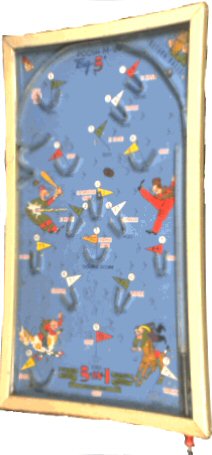
This tabletop Bagatelle game was donated to the Museum in 1982. The date of its manufacture is unknown, but is assumed to be in the previous decade. It was made by Northwestern Products Company, St. Louis, Missouri, USA. This company produced a number of Poosh-M-Up games such as this one which it called "Big 5".
The board, 60.5cm long x 32.3cm wide x 3cm high, is enclosed in a wooden frame and a clear glass top. It's made of wood, printed paper, tin, and uses nails and metal strips as deflectors in various places on the board's surface. The printed top surface has full color cartoons of baseball players, football players, horseback riders, etc.scattered over the surface. A number of target holes with embedded metal cups are cut into the board near each cartoon. Each cup is marked with a number or a numbered flag. The intent of the game is to accumulate points by having 2 included metal balls land in a target hole on the board's surface.
For proper play, the top of the board should be raised upon a support on the table so that the bottom of the board sits on the table and the entire board slants downward toward the player. Like most standard tabletop Bagatelle games, this game was designed for a right-handed player. On the right side of the board is a Runway - a covered metal channel which directs a metal ball to the top surface of the board, where a ball encounter a metal arch. This arch has a gap, and a ball can either fall into a parallel runway which returns the ball to the starting position, or allows the ball to roll freely on the board's surface. When a metal ball is at the base of the Runway and the board is properly slanted, the ball rests against a Plunger - a spring-loaded cylindrical rod which when operated by a player, propels the ball up the Runway. The Plunger is of red colored wood with a metal tip.
When a player pulls the Plunger and releases it, the Plunger cylinder hits a ball, propels it up the Runway, and then gravity takes over. The degree of propulsive force upon the ball is dependent upon how far out a player extents the Plunger from the board and how quickly the Plunger is released. Different degrees of force cause the ball to either enter the "return chute" or the "gap". If the ball enters "the gap" its descends onto the board surface, and rebounds against the sides of the board and against the embedded nails which deflect a ball from falling into a cup. As a ball rebounds against the nails it either falls into a cup (resulting in a player accumulating scoring points), or comes to rest at the bottom of the board. Playing options are printed in the lower center of the board.
Last update February 25, 2010